ANIMALS
Brave Woman Rescues Shark by Plunging Arm into its Mouth, Then Surprised by the Arrival of More Sharks
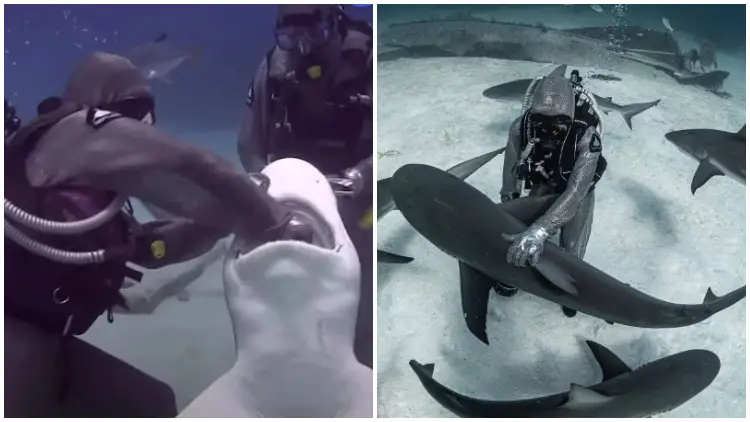
Sharks are often seen as powerful and intimidating creatures of the sea, evoking fear in many. While most people prefer to keep their distance from these awe-inspiring predators, there is a special group of individuals who are fascinated by their existence. Some possess an unwavering curiosity and determination to observe sharks up close, even in potentially dangerous waters. Today, we’ll introduce you to Cristina Zenato, a woman whose fearless interactions with sharks have captivated the attention of many. In this story, we’ll delve into Cristina’s inspiring journey and her remarkable commitment to safeguarding these magnificent creatures.
Cristina is a passionate enthusiast of sharks.
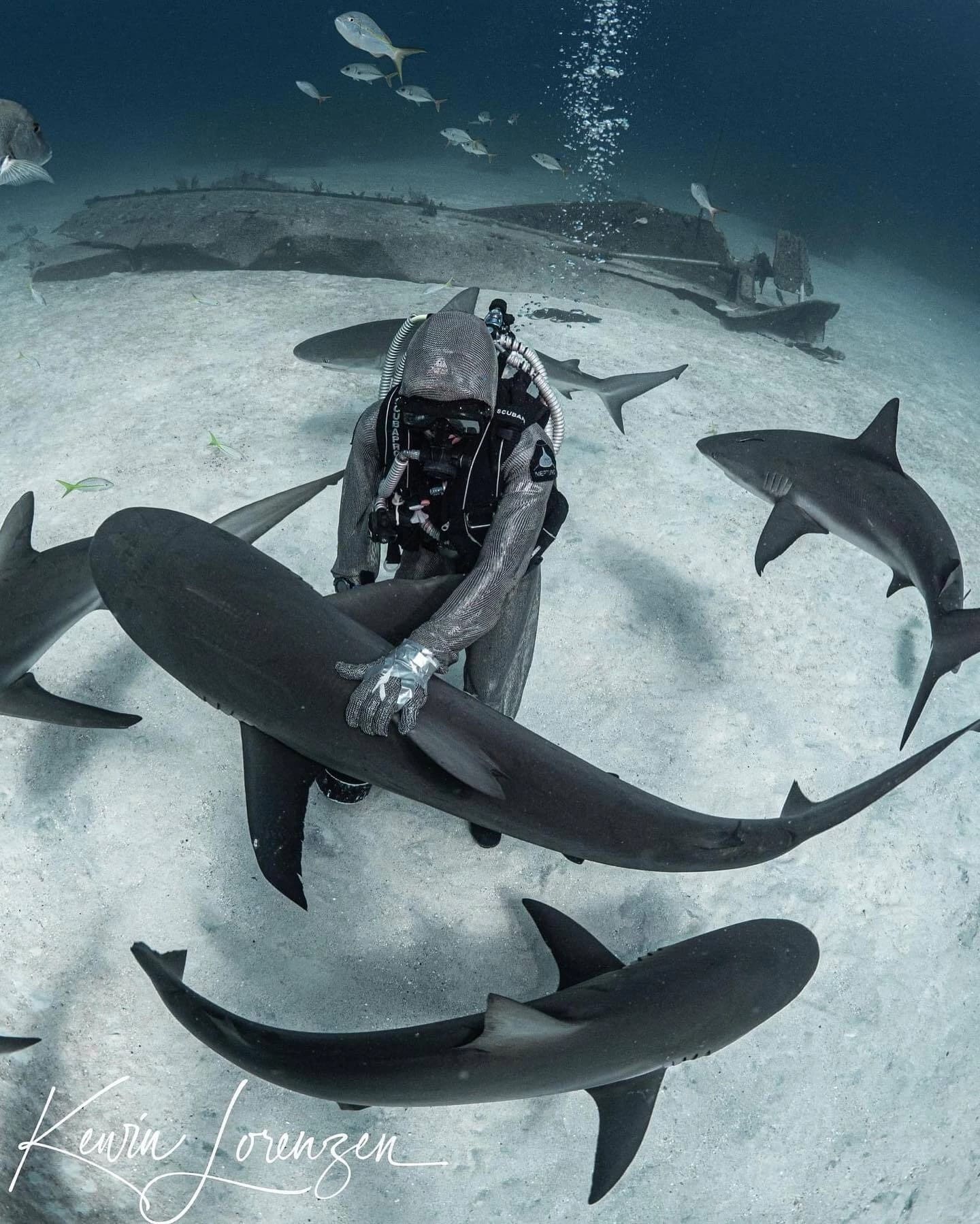 Image source: Cristina Zenato
Image source: Cristina Zenato
Unlike most shark observers who simply watch them from afar, she actively engages with sharks in their natural environment.
Ever since she laid eyes on a shark, Cristina has always dreamt of touching one.
 Image source: Cristina Zenato
Image source: Cristina Zenato
However, it took a whole year for her to transition from being a diver to pursuing a career centered around sharks. When that moment finally arrived, Cristina realized she had developed an addiction to working with these incredible creatures.
After spending time getting acquainted with the sharks that frequently visited her, Cristina grew to value and cherish them, considering them as some of her closest companions.
After spending a significant amount of time in their presence, Cristina noticed that many of her aquatic companions had fishing hooks stuck in their mouths.
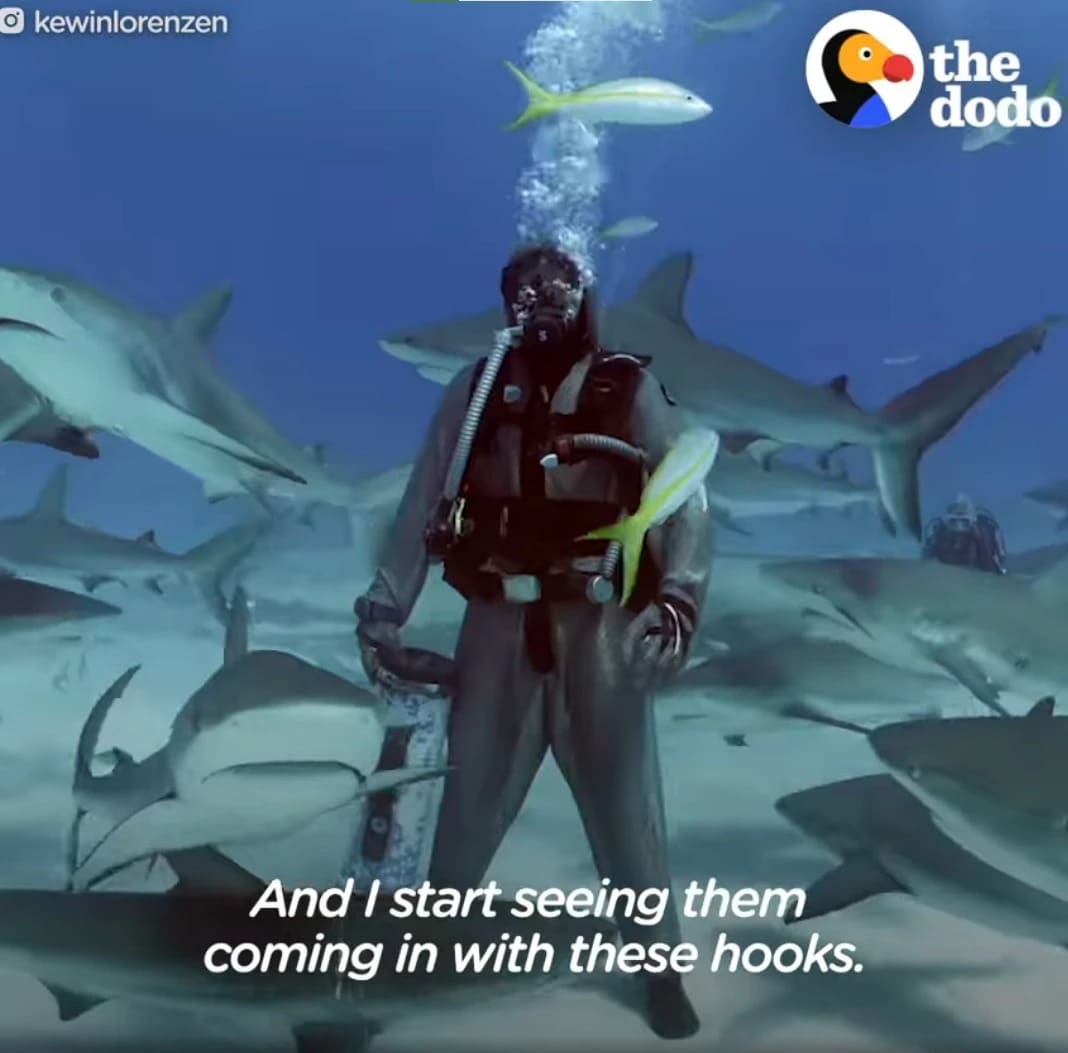 Image source: The Dodo
Image source: The Dodo
She realized that the hooks were causing pain to the sharks, so she made it her mission to remove them using her own hands, which the sharks didn’t have.
However, there was a challenge with this approach – she would need to put her fingers inside the sharks’ mouths.
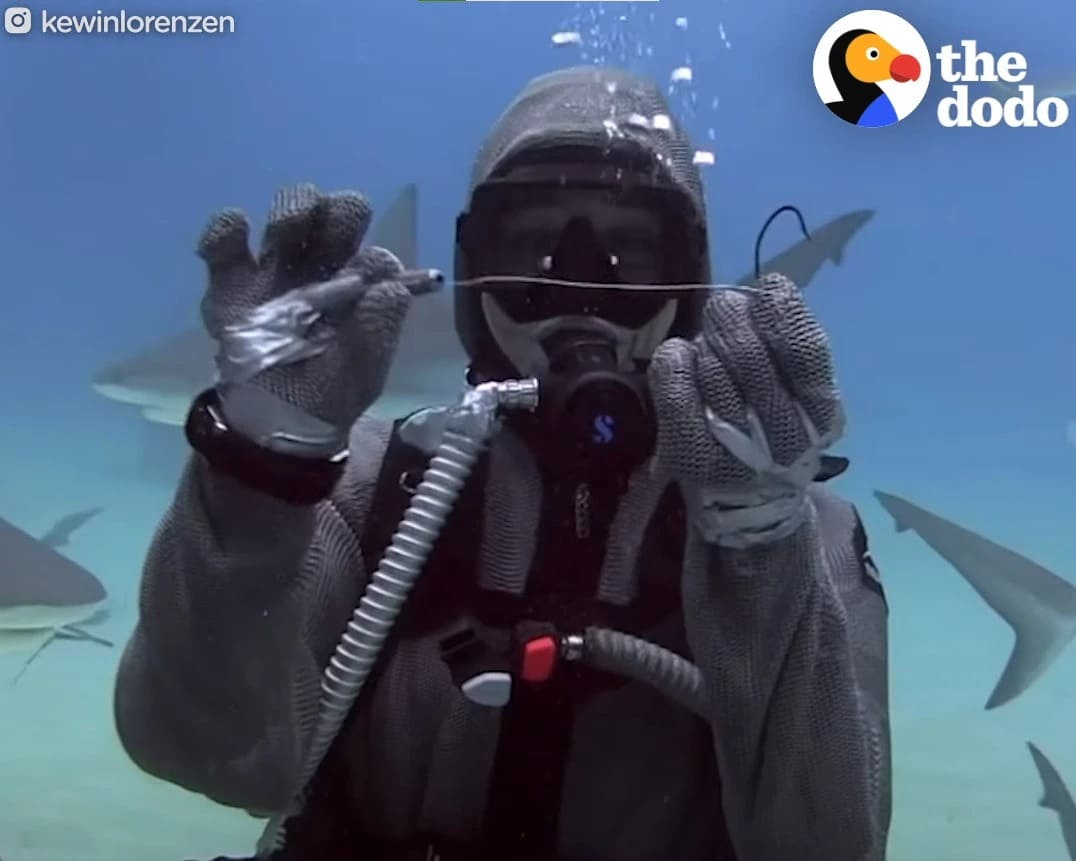 Image source: The Dodo
Image source: The Dodo
Sharks possess a remarkable number of teeth in their mouths, ranging from 5 to 15 rows and totaling up to 3000 teeth. Their most pointed and elongated teeth are the sharpest. Unlike other animals that rely solely on their lower jaw, sharks bite using both their upper and lower jaws. These unique characteristics make the task even more challenging than before.
However, Cristina recognized that she was the sharks’ only hope for salvation, despite the risks involved.
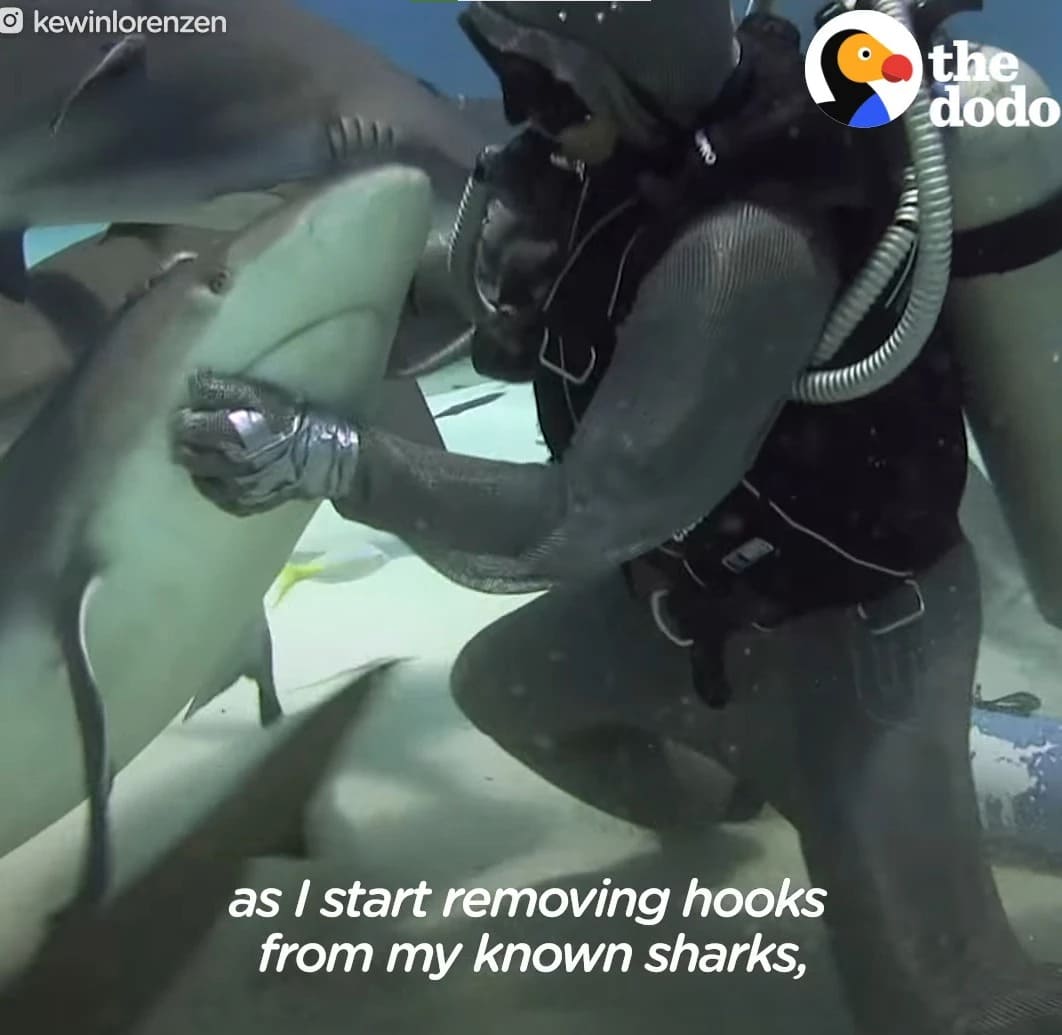 Image source: The Dodo
Image source: The Dodo
She had to trust these sea creatures completely, hoping they would comprehend that she was placing her hand inside their mouths for the well-being of all involved.
 Image source: The Dodo
Image source: The Dodo
Incredibly, these sharks granted Cristina the opportunity to begin rescuing them. With her hand inserted carefully into the back of one shark’s mouth, she successfully removed a hook.
According to Cristina, the shark now pays her a visit on every dive and greets her by gently touching her side.
 Image source: The Dodo
Image source: The Dodo
Cristina also believes that the effort she puts into removing the hooks is completely worth it when she witnesses the positive impact it has.
She shared in a video interview with The Dodo, a well-known animal channel: “When I remove the hooks, I feel happy, satisfied, and relieved. The other thing I notice is that as I start removing hooks from my known sharks, other sharks start showing up with hooks.”
 Image source: Cristina Zenato
Image source: Cristina Zenato
After spending a significant amount of time with them, Cristina firmly believes that sharks are often misunderstood.
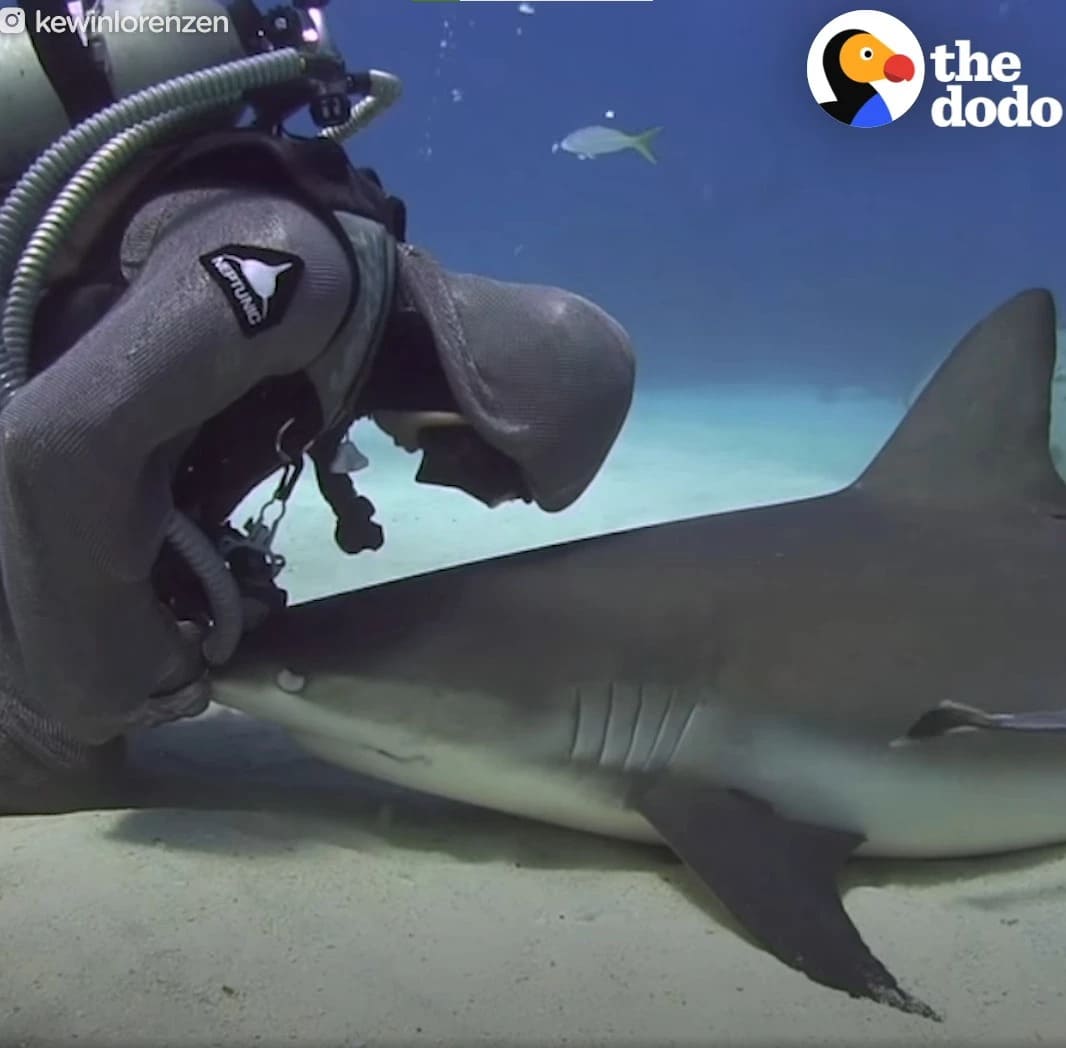 Image source: The Dodo
Image source: The Dodo
She said: “They’re very accepting. Sharks in general, in the world, are very tolerant of our presence entering their world.”
The sharks in Cristina’s tank appear to be quite accepting of her presence, allowing her to stroke them and swimming around her in a friendly manner. This could be due to their ability to sense Cristina’s affection towards them.
Watch the Video here:
ANIMALS
Amazing Video of Unseen Ocean Creatures in the Ningaloo Canyons

The Schmidt Ocean Institute recently explored the Ningaloo Canyons on the western coast of Australia using a robotic underwater vehicle called the ROV Sebastian. Check out the amazing video of what they discovered in the deep parts of the Indian Ocean.
More info: Youtube




ANIMALS
These Pics Are Art and the Artists Are Insects

Flying insects move so quickly that they are hard to follow, but new technology and some smart ideas have helped Spanish photographer Xavi Bou do just that. After spending 10 years focusing on birds in flight for his Ornithographies project, he turned his attention to insects.
For Entomographies, he uses high-speed video footage taken by Adrian Smith, an insect expert at North Carolina State University, to study and record how insects move. Bou then picks multiple frames and combines them into single images that show the fast movements of one or more insects through space and time.
With Smith’s help, Bou has captured the aerial tricks of wasps, the jumps of leafhoppers, and the fluttering of butterflies in amazing detail. He hopes that by doing this, he can make people more aware of the decline in important insect populations around the world.
1. Zebra longwing
This butterfly, which is common in many areas of the Americas, really fits its name. It can fly very high with just a few flaps of its large wings.
 Image source: nationalgeographic
Image source: nationalgeographic
2. Two-lined spittlebug
This insect, which comes from the eastern United States, is often seen as a pest because it likes to eat grass. Its springy back legs can make it jump into the air like a rocket.
 Image source: nationalgeographic
Image source: nationalgeographic
3. Yellow-collared scape moth
Unlike most moths, this North American species flies during the day. Its shiny blue-black wings sparkle in the sunlight.
 Image source: nationalgeographic
Image source: nationalgeographic
4. Ailanthus webworm moths
These tropical moths have spread farther north in the U.S. Because of their larval host, the invasive tree of heaven, they are now one of the most common backyard moths in the country.
 Image source: nationalgeographic
Image source: nationalgeographic
5. Common stonefly
Mostly found in eastern North America, this insect starts its life as an underwater nymph in forested streams or rivers. Then it leaves the water, sheds its skin, and becomes an adult with wings.
 Image source: nationalgeographic
Image source: nationalgeographic
6. Green lacewings
Eighty-seven species of this insect have been found in the U.S. and Canada. Since they eat a lot of unwanted plant pests like aphids and mites, they are often used to naturally control these pests.
 Image source: nationalgeographic
Image source: nationalgeographic
7. Grapevine beetle
This insect, fittingly named, eats the leaves and fruit of grapevines, both wild and farmed, but it doesn’t do much damage to the plants. As a type of scarab beetle, it often flies in a curved path.
 Image source: nationalgeographic
Image source: nationalgeographic
8. Oak treehopper and green treehopper
Treehoppers are known for their uniquely shaped pronotum, the part behind their head, which often looks like plant parts to hide from predators. They can jump well thanks to special muscles.
 Image source: nationalgeographic
Image source: nationalgeographic
9. Banded orange
This brightly colored butterfly can be found from Mexico to Brazil. Before mating season, male butterflies look for mineral salts, sometimes even drinking salty fluids from the skin, eyes, and nostrils of other animals.
 Image source: nationalgeographic
Image source: nationalgeographic
10. Sapho longwing
Longwings can live for 6 to 7 months, longer than most butterflies. This type, found from Mexico to Ecuador, has shiny blue wings, which is why it’s also called the Sapphire longwing.
 Image source: nationalgeographic
Image source: nationalgeographic
ANIMALS
Eagle and Fox in an Epic Midair Battle Over a Rabbit, Were Captured by a Photographer

Wildlife photography often depends on the perfect combination of good timing and the right place.
That’s exactly what happened when Kevin Ebi, an experienced wildlife photographer, captured an incredible battle between a bald eagle and a red fox, both competing for a rabbit meal.
In a detailed blog post, Ebi shares the fascinating series of events that unfolded while he was photographing foxes in San Juan Island National Historical Park, located in Washington state.
Ebi noticed a lively group of eight fox kits as they began their hunting lessons. Suddenly, they spotted a rabbit, and a thrilling chase ensued. Eventually, one of the foxes emerged as the winner, proudly carrying the rabbit across the field.
 Image source: Kevin Ebi
Image source: Kevin Ebi
Ebi shares what happened at that moment: “As I followed the fox with my camera, a sudden bald eagle cry caught my attention. It was swiftly approaching, clearly aiming for the rabbit. I quickly focused on the fox, anticipating a quick turnover of events.”
To Ebi’s astonishment, instead of a quick surrender, the situation turned into a intense fight in the air.
The eagle used its power to lift the fox and rabbit high up in the sky. Even while airborne, the fox attempted to break free by swinging back and forth.
 Image source: Kevin Ebi
Image source: Kevin Ebi
 Image source: Kevin Ebi
Image source: Kevin Ebi
 Image source: Kevin Ebi
Image source: Kevin Ebi
In the end, the eagle moved the rabbit to its other claw, causing the fox to let go. The intense battle came to an end in less than 10 seconds.
 Image source: Kevin Ebi
Image source: Kevin Ebi
For those worried about the fox’s well-being after the fight, Ebi reassures that it was not injured. The fox swiftly bounced back from the encounter and resumed its playful behavior with the other young foxes, showing no visible wounds from the aerial clash.
 Image source: Kevin Ebi
Image source: Kevin Ebi
 Image source: Kevin Ebi
Image source: Kevin Ebi
 Image source: Kevin Ebi
Image source: Kevin Ebi
 Image source: Kevin Ebi
Image source: Kevin Ebi
-

 GARDEN10 tháng ago
GARDEN10 tháng ago4 Easiest Ways to Get Free Plants
-

 ANIMALS10 tháng ago
ANIMALS10 tháng agoBritish Angler Caught Huge 67-Pound Goldfish in the World
-

 FUNNY10 tháng ago
FUNNY10 tháng ago30 Weirdest Things That People Came Across On The Subway
-

 FUNNY10 tháng ago
FUNNY10 tháng ago30 Funny and Perplexing Photos That Make You Laugh All Day
-

 GARDEN9 tháng ago
GARDEN9 tháng ago30 Shimmering Side Yard Landscape Ideas
-

 ANIMALS10 tháng ago
ANIMALS10 tháng agoKindhearted Driver Rescues Skinny Dog Hiding Near Highway Thanks to His Eagle Eye
-

 FUNNY10 tháng ago
FUNNY10 tháng ago22 Design Fails That Will Make You Laugh Out Loud
-

 ANIMALS10 tháng ago
ANIMALS10 tháng agoMore Than 3 Million People Baffled by Video of Strange Figure on the Beach





